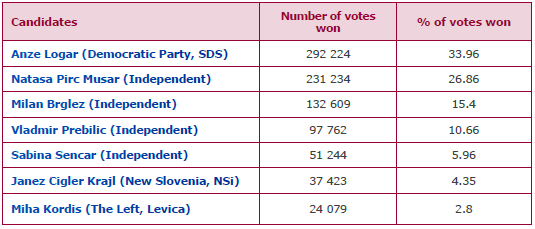Results
Elections in Europe
Corinne Deloy
-

Available versions :
EN

Corinne Deloy
As forecast by opinion polls, Anze Logar (Democratic Party, SDS), former Minister of Foreign Affairs (2020-2022) in the government of Janez Jansa (SDS), came out ahead in the first round of Slovenia's presidential election on 23 October. With 33.96% of the vote, he beat Natasa Pirc Musar, a lawyer and information commissioner (ombudsman) between 2004 and 2014, who garnered 26.86% of the vote. She ran as an independent but was supported by former heads of state Milan Kucan (1991-2002) and Danilo Turk (2007-2012) as well as by the Youth Party-European Greens (SMS) and the Pirate Party.
Anze Logar won in the rural areas of the country while Natasa Pirc Musar came first in the larger cities, such as Ljubljana, Maribor and Kranj. The two candidates will meet again on 13 November for the second round of the presidential election.
Milan Brglez, MEP, supported by the Freedom Movement (GS) of Prime Minister Robert Golob and by the Social Democrats (SD), the party from which he comes, took third place with 15.4%. He was followed by Vladmir Prebilic, mayor of Kocevje since 2010, supported by Vesna-Green Party (VESNA) of Uros Maceri and Ursa Zgojznik, who took 10.66%; Sabina Sencar, supported by Resni. ca, a populist party led by Zoran Stevanovic, who scored 5.96%; Janez Cigler Krajl (New Slovenia, NSi), former Minister of Labour, Family, Social Affairs and Equal Opportunities (2020-2022) 4.35%; and Miha Kordis (The Left, Levica), 2.8%.
Turnout was low, with only one in two Slovenes (51.06%) going to the polls, although this was more than in the first round of the previous presidential election on 22 October 2017 (+7.49 points).
Results of the first round of the presidential election in Slovenia on 23 October 2022
Turnout: 51.06%

Source : Electoral Commission
During his election campaign, Anze Logar presented himself as a unifier of "voters from all sides to prepare the future together". "I stood as I am, a moderate, and my campaign will continue in this way," he said when the results were announced.
He nevertheless invited former Prime Minister (2020-2022) Janez Jansa to celebrate his position in the first round. The latter had faced numerous protests during his two years in power. Slovenians took to the streets several times to express their discontent, opposition MPs tabled numerous motions of no confidence, but to no avail. The head of government was also called to order by the European Union, particularly for his media policy, as Janez Jansa was accused of not respecting media plurality. Thus, at the end of 2020, he had stopped paying the Information Agency (STA) the public funds allocated to it and necessary for its operation. The agency was finally able to receive its usual subsidy almost a year later, in November 2021.
Natasa Pirc Musar aspires to become the first woman president of the Republic of Slovenia. "I think the time has come for Slovenia," she said. She appealed to left-wing voters as soon as the results were announced. Prime Minister Robert Golob said he would support her after the defeat of her candidate Milan Brglez. "We know what our duty is: without any qualms, we stand behind the best candidate who shares values close to our own," he said. A victory of the Democratic Party candidate would be a setback for Prime Minister Robert Golob (Movement for Freedom, GS), who has been in office since 1 June after his party's victory in the general elections of 24 April. It would make the head of government's task more difficult.
Observers of Slovenian politics believe that moderate voters should rally and mobilise against Anze Logar in the second round of voting. However, Natasa Pirc Musar, who lost in the first round, has a large reserve of votes and remains the favourite in the presidential election.
On the same theme
To go further
Elections in Europe
Corinne Deloy
—
15 April 2025
Elections in Europe
Corinne Deloy
—
25 February 2025
Elections in Europe
Corinne Deloy
—
18 February 2025
Elections in Europe
Corinne Deloy
—
28 January 2025

The Letter
Schuman
European news of the week
Unique in its genre, with its 200,000 subscribers and its editions in 6 languages (French, English, German, Spanish, Polish and Ukrainian), it has brought to you, for 15 years, a summary of European news, more needed now than ever
Versions :



